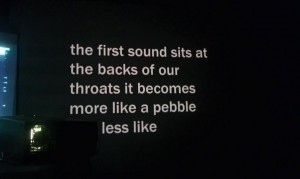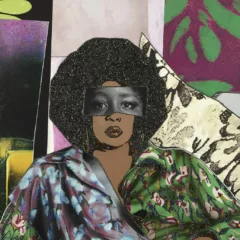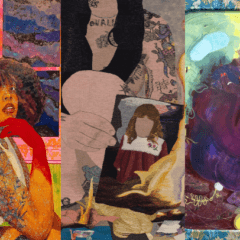[It’s been nearly three years since Libby gave an incisive review of a new-media performance and art show at Vox Populi. Having immersed ourselves in our devices all the more since then, we thought we could all use a reminder that texting and other less personal forms of communication can, sometimes, elevate us. — the Artblog editors]
My first outing to AUX, the newish performance space at Vox Populi Gallery, last week was an extraordinary mix of pain and transcendence. The event, Rhythms of Time Sharing (RoTS), showcased several communications-technology-based performances, including work from artists based here, in the nation and across the pond. The event, presented by the London-based collective KIOSK, was a curatorial exploration of the current state of new media in art.
Talk to Me
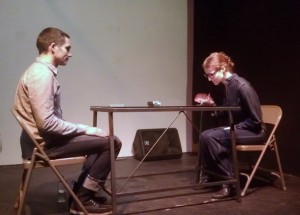
The high point–using text messages–was an interactive performance by Brooklyn-based artists Joao Enxuto and Erica Love, who collaborate under the name the original copy. In their performance, Talk to Me, they play a couple reading text messages to each other, the texts supplied by the audience.
It was a dark and rainy weeknight, however, and the audience in AUX was small, less than 20 when I counted. But the audience was greater than the people in the room, thanks to another layer of technology streaming in and out of the UK. Alas, the audience was a little reluctant to interact, raising the level of tension as well as the discussion about lack of meaningful communication between Enxuto’s and Love’s characters.
What made Talk to Me so successful were the theatrics, the fourth wall broken not just via technology but via the actors…and the irony that communications technology had created a fourth wall of sorts between the two lovers in much the way that we have our noses in our cell phones when we ought to be talking to the person right in front of us. This work was thoughtful and engaging, making successful use of the technology, but putting it in a human context with a will-they-won’t-they-? plot driving the action forward in time.
Bonnie Jones, a Maryland-based artist who uses text and music in her improvised and composed performances, projected a poem on a screen in rhythmic bursts of typing and copied/pasted text. The words and their presentation were a cosmic meditation on the desire to communicate and how technology mediates. I found myself thinking of the percussive, aggressive word art of Heavy Industries, but the mellow jazziness of Jones’ poem was quite different–more like a haiku than a Howl.
Love, encoded
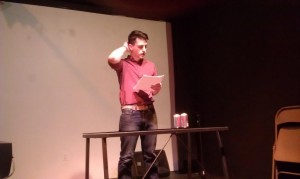
The ecstasy was palpable in Matt Kalasky‘s performance/reading of a tale of two early Match.com web developers who find each other via their own tech-savvy device in what amounts to an e-epistolatory short story. Why, I wondered, did Kalasky’s persona down two cans of Diet Coke? Why was one of the lovers his mom? With ironic nostalgia for early Internet culture, the story builds to its predictable climax after actual bits of computer code (fictional, I presume) become part of the mating dance. It was highly entertaining and a nice addition to the discussion of the role of technology in communication. Kalasky is a Philadelphia artist and writer, chief editor of The Nicola Midnight St. Claire.
Also worthwhile and layered with ideas was a political film by New York-based Rainer Ganahl featuring a copy of Friedrich Engels’ The Condition of the Working Class in England…being kicked down the streets of a deserted English mill town fallen victim to economic and technological changes. Ganahl represented Austria in the Venice Biennale in 1999.
Unsuccessful Twitter try
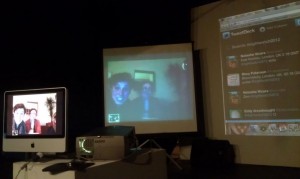
The framework of the evening, however, was pure agony–an intercontinental, interactive Twitter feed at #nightwatch2012–arty and infertile. An equally arty performance by the Bristol (Engand)-based group the Collect, with a trite visual metaphor of a man untangling wires, also fell flat.
KIOSK’s trio of sleepy curators in England (it was past 2am GMT) participated with the AUX crowd in a post-performance discussion on Skype. One of them suggested the word agony to describe much of the evening’s experience. That helped break the ice.
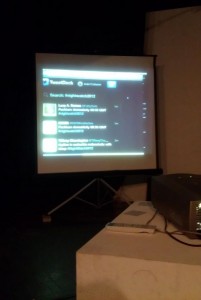
For all the agony, though, I found the evening fruitful. It brought to mind tedious early art videos, and how the process of learning to take advantage of a new technology takes experimentation and time until a vocabulary of useful strategies and precedents get built.
Since AUX opened over the summer, there’s been a steady stream of performances and screenings there–a space for taking risks. In that light, the agony was to be expected and was not for everyone. The ecstasy–I’d return for more (although there’s not much continuity in what gets shown at AUX; every performance is an adventure).


